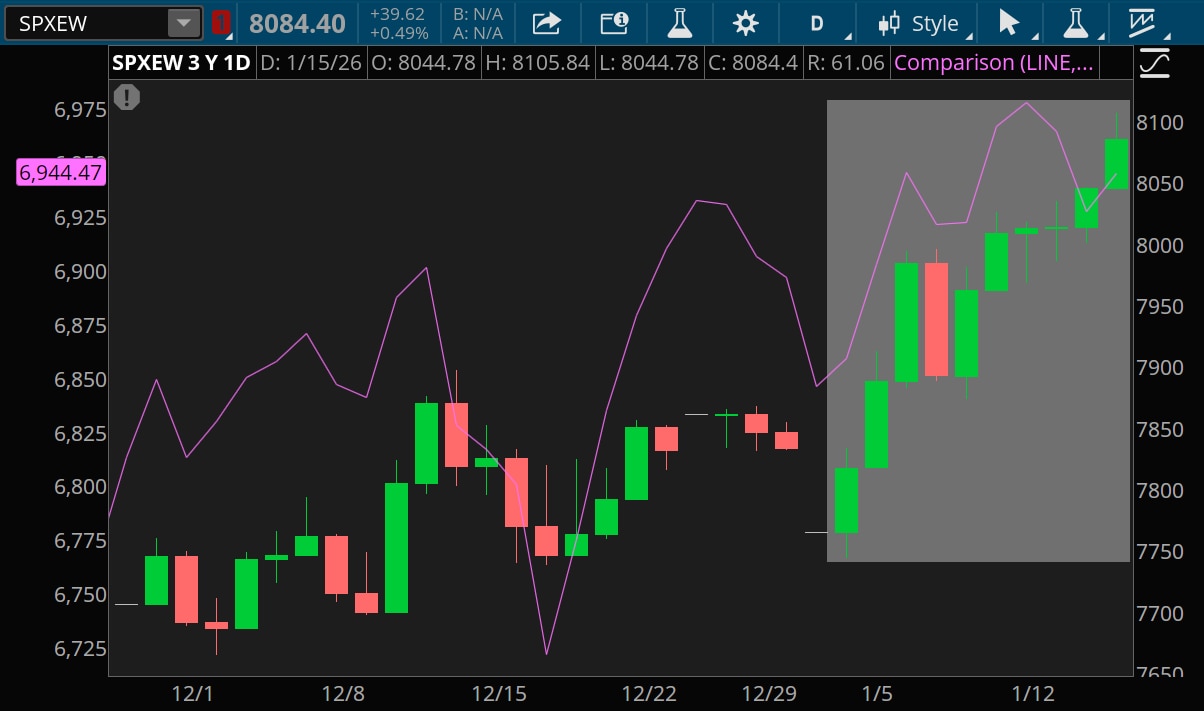Tech Stocks on Track for a Second Day of Gains

Published as of: January 16, 2026, 9:21 a.m. ET
Listen to this article
Listen to this article here or subscribe to the Schwab Market Update podcast in your favorite podcast app.
| The markets | Last price | Change | % change |
|---|---|---|---|
| S&P 500® index | 6,944.47 | +17.87 | +0.26% |
| Dow Jones Industrial Average® | 49,442.44 | +292.81 | +0.60% |
| Nasdaq Composite® | 23,530.02 | +58.27 | +0.25% |
| 10-year Treasury yield | 4.19% | +0.02 | -- |
| U.S. Dollar Index | 99.24 |
–0.08 |
–0.32% |
| Cboe Volatility Index® | 15.71 | –0.13 | –0.82% |
| WTI Crude Oil | $59.80 | +$0.72 | +1.22% |
| Bitcoin | $95,570 | +$215 |
+0.23% |
(Friday market open) Tech stocks were poised for a second day of gains Friday, with semiconductor stocks set to open higher as momentum carries over from Taiwan Semiconductor Manufacturing's (TSM) earnings report. PNC Financial (PNC) continued a string of upbeat earnings news from banks before the bell. Overall, small cap stocks looked set to lead the way again, while the S&P 500 and Dow Jones Industrial Average were both flat before the open.
The day's calendar is relatively light on earnings and economic news. Industrial production for December is due out just before the market open, providing a reading on the health of the nation's factories. Federal Reserve officials Susan Collins and Michelle Bowman will speak this morning, while Vice Chair Philip Jefferson will speak this afternoon. Markets will be closed Monday for the Martin Luther King Jr. holiday.
On Thursday, stocks broke a two-day losing streak but closed well off their highs as earnings reports boosted technology stocks and big banks. Tech stocks rebounded after Taiwan Semiconductor Manufacturing disclosed big investment plans to meet demand for AI chips. Morgan Stanley (MS), Goldman Sachs (GS), and BlackRock (BLK) all rose more than 4% after reporting earnings. Still, small-cap stocks continued to outpace as investors broaden their search for returns. Oil tumbled and related energy stocks fell as U.S.-Iran tensions seemed to cool down. Silver hit another record high.
To get the Schwab Market Update in your inbox every morning, subscribe on Schwab.com.
Three things to watch
- Everything old is new again? "Rotation" remains the operative word for stocks through the first half of January. As of Wednesday, five of the Mag 7 stocks were in the red for the year and ranked in the bottom 100 among index members in price performance, underscoring that investors are looking elsewhere for gains. Meanwhile, the energy, materials, industrial, and consumer staples sectors were all up nearly 6%, with more than half of the companies in each sector at 4-week highs. Consider also that more than half of S&P 500 members are outperforming the cap-weighted index, and both the equal-weighted S&P 500 and the equal weighted Russell 2000 are outperforming their cap-weighted counterparts. The equal-weighted gauges are important indicators of market breadth and the absolute rise in the equal-weight S&P 500 confirms market breadth and makes for a more durable market advance, said my colleague Liz Ann Sonders, chief investment strategist at the Schwab Center for Financial Research (SCFR). The rotation also shows that market cap can cut both ways in index performance.
- The clock is ticking on Capitol Hill: The longest government shutdown in U.S. history is still visible in the rearview mirror as Congress rapidly approaches a deadline—January 30—to avoid another. So far only three of the 12 appropriations bills needed to keep the government fully operational have passed Congress, and those don't include the most contentious ones: the Pentagon, Homeland Security, Labor, and Health and Human Services. Getting them done by the end of the month is a longshot, but neither party seems interested in another shutdown, said Michael Townsend, managing director of legislative and regulatory affairs at Schwab. "I expect most of the appropriations bills to be completed in time, and then a temporary extension of funding for the rest while negotiations continue," Townsend said. "I can't rule a shutdown out, but the odds seem low at this point."
- Into the ether: The blockchain Ethereum, home to the cryptocurrency ether, is seeing surging levels of activity as financial institutions wade into tokenization, staking, and other applications. This week Ethereum has seen a record number of transactions, new addresses, and number of ether coins staked, or pledged for the transaction-validation process in exchange for rewards. Compared with bitcoin, ether's value proposition is less about offering a store of value and more about the commercial possibilities of the blockchain. (Ether is required to conduct transactions.) Just last month, JPMorgan said it would launch its first tokenized money market fund on Ethereum. Consulting firm McKinsey & Company has estimated that the market cap of tokenized assets will reach around $2 trillion by 2030. "As institutions look to move on chain, they are more likely to do so on Ethereum as it is the oldest and largest smart contract platform. It's viewed as the industry standard," said Jim Ferraioli, director of digital currencies research and strategy at SCFR. "The key debate is whether it can scale to support more robust growth and activity on its blockchain."
On the move
ImmunityBio (IBRX) rose more than 15% in pre-market trading after soaring more than 30% on Thursday after it issued strong guidance for its bladder-cancer drug.
Semiconductor stocks were mostly higher in early trade after advancing Thursday. Advanced Micro Devices (AMD) rose more than 2%, Marvell Technology (MRVL) was up more than 1%, and Broadcom (AVGO) was up nearly 1%.
Memory-chip makers rose in early trade. Micron Technology (MU) jumped nearly 5% after a board member bought nearly $8 million worth of shares in the company. Sandisk (SNDK), Western Digital (WDC), and Seagate Technology (STX) all rose more than 3% in pre-market action.
PNC Financial (PNC) rose nearly 3% in early trade after the bank reported earnings that beat expectations. PNC said profit rose 25% in the fourth quarter, thanks to rising revenue from interest payments and dealmaking, and said revenue would rise 11% in 2026, above expectations.
Shares in J.B. Hunt (JBHT) dropped more than 3% in pre-market trading after the logistics company reported lower quarterly revenue due to a decline in transcontinental load volumes.
Coupang (CPNG) rose nearly 3% in pre-market trading following an upgrade to buy by Deutsche Bank, which said regulatory uncertainty by the Korean retailer has been mostly priced in.
Crude oil (/CL) fell more than 4% as traders reassessed the likelihood of a U.S. military strike on Iran following comments from President Donald Trump.
Silver (/SI) future rose more than 1% to a record high, while gold (/GC) futures fell less than 1% from a record high.
Bitcoin (/BTC) futures retreated Thursday, falling more than 1% from a two-month high after the Senate Banking Committee delayed a vote on a key market structure bill. Bitcoin was trading slightly higher early Friday.
More insights from Schwab

Fed drama, dissected: Fed independence came into focus again this week amid news of a criminal investigation into current Chair Jerome Powell and speculation about his successor. The latest episode of the OnInvesting podcast with Sonders and Kathy Jones, chief fixed income strategist at SCFR explores the current state of the central bank and its potential impact on equities, the housing market, and more.
What is the VVIX and why should you care? The "VIX of the VIX" is a gauge of market participants' views of future volatility and a useful tool for gauging market sentiment. Read this guide to the lesser-known cousin of the "fear gauge."
Tackling the long-term care topic: Discussing the potential need for long-term care can be a challenging topic for adult children to bring up with their parents as they age. But my colleague Chris Kawashima explains that putting off the conversation until a later time isn't the answer.
Chart of the day

Data source: NYSE. Chart source: thinkorswim® platform.
Past performance is no guarantee of future results.
For illustrative purposes only.
So far this year, the equal-weighted S&P 500 index (SPXEW–candlesticks) has risen about 4%, more than doubling the return of the capitalization-weighted index (SPX–line). This outperformance illustrates the current rotation from megacap tech stocks into the broader market.
The week ahead
Check out the investors' calendar for a summary of the top economic events and earnings reports on tap this week.
January 19: No data or earnings, markets closed in observance of Dr. Martin Luther King Jr.'s birthday.
January 20: Expected earnings from 3M (MMM), U.S. Bancorp (USB), Fastenal (FAST), D.R. Horton (DHI), Fifth Third Bancorp (FITB), KeyCorp (KEY), Netflix (NFLX), Interactive Brokers Group (IBKR), and United Airlines (UAL).
January 21: Expected earnings from Johnson & Johnson (JNJ), Truist (TFC), Halliburton (HAL), Kinder Morgan (KMI), and Steel Dynamics (STLD).
January 22: Q3 GDP final estimate and expected earnings from GE Aerospace (GE), Procter & Gamble (PG), Abbott Laboratories (ABT), Freeport-McMoRan (FCX), Intel (INTC), Intuitive Surgical (ISRG), Capital One Financial (COF), and CSX (CSX).
January 23: Expected earnings from Nextera Energy (NEE), First Citizens BancShares (FCNA), and Comerica (CMA). University of Michigan consumer sentiment survey final results for January.